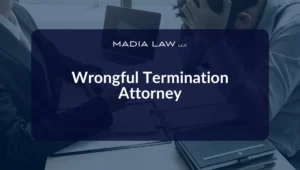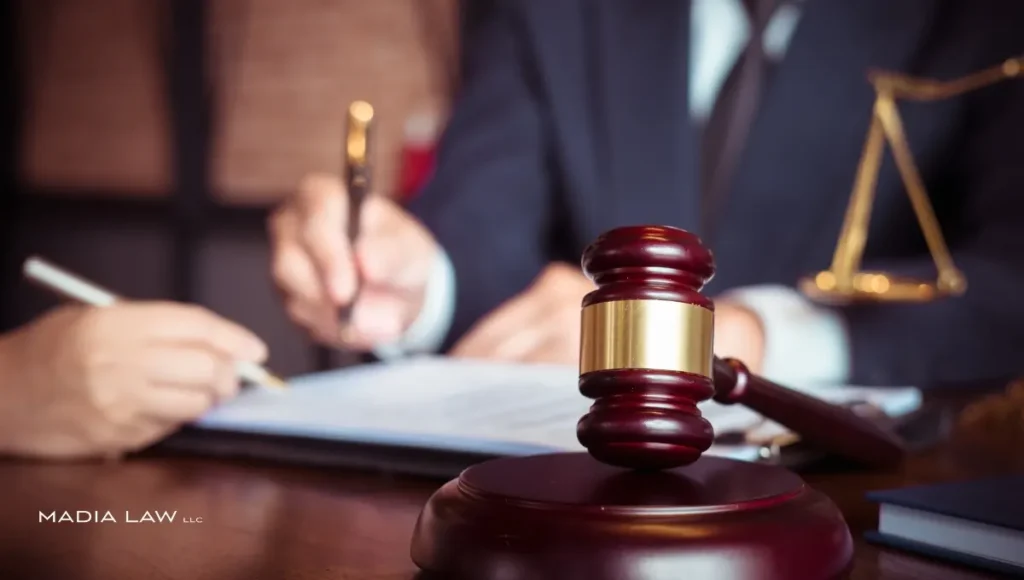
Losing your job is hard enough as it is, but when it happens for the wrong reasons, it’s more than unfair—it’s illegal. If you were fired for speaking out, reporting misconduct, requesting medical leave, or standing up against discrimination, you may have a strong legal claim.
At Madia Law, we represent employees in Minneapolis / St. Paul and across the great state of Minnesota who’ve been wrongfully terminated, and we hold employers accountable when they violate the law. We’ve recovered over $10 million for workers who were fired for unlawful reasons.
Minnesota law protects you from retaliation and wrongful discharge, but those protections mean nothing unless you act swiftly and thoroughly. As your attorney, we’ll work with you to preserve evidence, file the right claims, and pursue maximum compensation for your lost wages, emotional distress, and future career impact.
You don’t have to go through this ordeal alone. Contact Madia Law LLC today for a confidential, no-obligation consultation, and let’s take the first step toward justice together.
Think You Were Wrongfully Terminated? Know Your Legal Options in Minneapolis
In Minnesota, most employment is considered at-will, which means your employer can let you go for almost any reason or even no reason at all. But still, that doesn’t give them a free pass to break the law.
There are clear legal exceptions to at-will employment. If you were fired for reasons that violate state or federal employment laws, you may have a strong wrongful termination claim.
The key to proving wrongful termination is knowing why you were fired and having the evidence to back it up. At Madia Law, we help you make sense of your situation, determine if your rights were violated, and take legal action if your employer broke the law.
What Legally Qualifies as Wrongful Termination in Minnesota
Not every firing is illegal, but under Minnesota and federal law, certain reasons for termination are strictly prohibited. If you were let go for any of the reasons below, you may have a strong wrongful termination case.
Here are the 5 most common legally actionable grounds for wrongful termination in Minnesota:
- Retaliation: Being fired for reporting illegal activity, filing a complaint, or cooperating in a workplace investigation.
- Discrimination: Termination based on protected characteristics like race, gender, religion, age, disability, sexual orientation, or pregnancy.
- Medical or Family Leave: Being let go for taking protected leave under the FMLA, Minnesota Parenting Leave Act, or for requesting a reasonable accommodation for a medical condition.
- Whistleblowing: Losing your job after reporting fraud, safety violations, or other illegal actions under public or private sector whistleblower protections.
- Breach of Employment Contract: Being fired in violation of the terms laid out in an employment agreement, company handbook, or implied promise of continued employment.

Common Signs of Unlawful Termination
It’s not always clear when a firing crosses the line from unfair to unlawful, but there are red flags that may signal your rights have been violated. As an experienced Minnesota lawyer for unlawful termination, we have seen the patterns local employers use to cover up illegal motives. If you’ve experienced any signs of wrongful termination mentioned below, it’s time to take a closer look at your situation:
- Sudden negative performance reviews after a strong track record of positive feedback
- Being excluded from meetings, communications, or projects shortly after reporting a problem or filing a complaint
- Termination that happens right after you request leave, report misconduct, or assert your legal rights
- Vague or constantly changing reasons for why you were let go
- A paper trail that tells a different story – like emails, evaluations, or HR notes that contradict your employer’s explanation
Wrongful Dismissal vs. At-Will Employment: What You Need to Know
Most jobs in Minnesota fall under at-will employment, which means your employer can let you go at any time, without notice, without warning, and without giving a reason. But at-will does not mean without limits.
Your employer cannot use the at-will label to cover up an illegal firing. When a termination violates your legal rights, it becomes a wrongful dismissal, no matter what the company claims.
Common examples of wrongful dismissal include being fired for:
- Reporting harassment, discrimination, or other workplace misconduct
- Requesting protected leave under the FMLA or state law
- Refusing to take part in illegal or unethical behavior
- Belonging to a protected class, such as race, gender, age, religion, disability, or sexual orientation
We’ve seen Minnesota employers of all sizes in different industries try to justify terminations under “at-will” to avoid liability, but the real reason for your firing still matters and needs to come to light. If your rights were violated, we can expose the truth and hold your employer accountable under Minnesota law.
Statute of Limitation: How Long Do I Have to File a Wrongful Termination Claim?
Timing is everything. In Minnesota, the deadline to file a claim (known as the statute of limitations) varies depending on the type of claim you’re pursuing and which agency or court will handle your case.
| Type of Claim | Where to File | Deadline |
|---|---|---|
| Discrimination or Retaliation | EEOC (federal) | 300 days from termination |
| Discrimination or Retaliation | Minnesota Department of Human Rights (MDHR) | 1 year |
| Breach of Contract | Minnesota State Court | 2 years from termination |
| Whistleblower Retaliation (Minnesota law) | Minnesota State Court | 6 years |
Tip: Speak with a wrongful termination attorney as soon as possible after you’ve been fired. The earlier we get involved, the better we can protect your rights. Save any emails, text messages, performance reviews, or documents related to your employment. These can become powerful pieces of evidence and significantly strengthen your case down the line.
For a legal consultation with a wrongful termination lawyer serving Minneapolis, call 612-349-2729
Why Hire a Minneapolis Wrongful Termination Lawyer for Your Case
When you’ve been wrongfully fired, it can feel like the odds are stacked against you… and in many ways, they are. Your employer has experienced HR teams, well-paid lawyers, and carefully crafted policies, all working to protect the company, not you. Their goal is to shut down claims quickly, shift blame, and avoid responsibility.
Our lawyers know how to level the playing field. As your wrongful termination attorney, we’ll cut through the company’s missteps and excuses, expose unlawful motives, and fight to make sure your voice is heard.

Benefits of Having a Legal Advocate After Being Terminated
As a Minneapolis wrongful termination attorney, we don’t just handle paperwork. We stand up for you when it feels like no one else will and protect your reputation, your career, and your future.
Here’s what you gain when you have a dedicated legal advocate on your side:
Clear Legal Analysis of Your Termination
- We review the facts and determine whether your firing violates Minnesota or federal employment laws, so you know exactly where you stand.
Thorough Evidence Review and Case Building
- We help secure and organize critical documents like performance reviews, emails, internal memos, and messages. These communication records can strengthen your claim and reveal the real reasons behind your termination.
Protection Against Retaliation
- If your former employer tries to interfere with your job search or takes further adverse action, we protect your rights and hold them accountable.
Negotiation of Severance Agreements
- We carefully review and negotiate severance packages to ensure you’re not giving up your legal rights without fair compensation.
Strategic Filing of Claims
- We guide you through filing with the EEOC, Minnesota Department of Human Rights (MDHR), or directly through the courts, making sure everything is done properly and on time.
Minneapolis Wrongful Termination Lawyer Near Me 612-349-2729
Types of Unlawful Termination Cases We Handle
We represent employees fired for reasons that violate state or federal law. Here are the most common cases we handle at Madia Law. Each has its legal standards, timelines, and strategies.
Retaliation for Reporting Misconduct or Whistleblowing
If you were fired after reporting illegal activity or serious misconduct at work, that’s not just morally questionable; it may be defined as retaliation that is illegal under both Minnesota and federal law.
Whistleblower protections exist to shield employees who speak up about:
- Discrimination or harassment
- Wage theft or unpaid overtime
- Unsafe or hazardous working conditions
- Fraud, ethics violations, or other unlawful conduct by an employer
It doesn’t matter whether you reported the issue internally or to a government agency; you have legal protection either way. If your employer fired you in response, you may have a strong wrongful termination case.
At Madia Law, we’ve successfully helped clients in these situations, including recently securing a $300,000 pre-litigation settlement for a Minnesota employee fired just days after reporting ethics violations.
Termination Based on Race, Gender, Disability, or Religion
Being fired because of characteristics that define who you are, such as race, gender, disability, religion, or sexual orientation, is discrimination and a clear violation of federal and Minnesota law.
Your employer cannot legally terminate you because of:
- Your race, national origin, or cultural background
- Your gender, gender identity, or sexual orientation
- A disability or medical condition
- Your religious beliefs or practices
These protections are guaranteed under Title VII of the Civil Rights Act, the Americans with Disabilities Act (ADA), and the Minnesota Human Rights Act.

Our lawyers at Madia Law have helped clients hold employers accountable in serious discrimination cases, including securing a $2.4 million settlement for an employee wrongfully fired after reporting gender discrimination.
If you believe your termination was based on your identity, contact us today. We’ll review your case, explain your rights, and stand by your side to make sure justice is served.
Wrongful Firing Due to Medical Leave or Pregnancy
You can’t be fired, excluded from promotions, or have your hours cut for taking protected medical or family leave. Under the Family and Medical Leave Act (FMLA) and Minnesota law, employees are entitled to time off for:
- Serious health conditions
- Disability-related treatment or recovery
- Pregnancy, childbirth, and postnatal care
- Caring for a family member with a serious medical issue
Breach of Employment Contract or Implied Agreements
You have a wrongful termination claim for breach of contract if you were fired violating a written or implied employment agreement. Even in at-will states like Minnesota, contracts and implied commitments override at-will rules when the employer fails to uphold them.
This applies when:
- Your termination violates terms in a signed contract, offer letter, or employment agreement
- Company policies, handbooks, or past practices created a reasonable expectation of job security
- Promises made verbally or in writing weren’t honored by your employer
Click to contact our Employment Lawyers in Minneapolis for Workplace Legal Issues today
How Our Minneapolis Attorneys Prove Wrongful Termination
Proving wrongful termination is not about what actually happened but what you are able to prove. At Madia Law, we use a strategic, evidence-backed approach to show that your firing violated the law.
We focus on a 3-step process to build a case that holds up in court or drives a strong settlement:
- Gathering documentation and witness statements
- Consulting legal and employment experts
- Filing formal claims with the right agencies on time
1. Gathering Evidence: Emails, Witnesses, and Documentation
Solid evidence is the backbone of any wrongful termination case. At Madia Law, we help clients collect and preserve proof that shows why they were fired and what happened behind the scenes.
Key evidence includes:
- Emails and written communications with supervisors or HR
- Performance reviews or disciplinary records showing inconsistencies
- Witness statements from coworkers who observed retaliation, bias, or sudden treatment changes
- HR policies or employee handbooks that contradict the employer’s actions
- Documentation of complaints filed before termination (internal or with agencies)
Talk to our team immediately if you believe your firing was unlawful. Preserving evidence early makes or breaks your case.
2. Working with Employment Experts and Legal Strategists
Wrongful termination cases often include interpretation of policies, intent, and damages. We work with trusted employment law experts and HR professionals to support your claim.
These experts help:
- Analyze how your employer’s actions violated workplace standards or policies
- Assess economic losses, like missed wages and future earning potential
- Strengthen your case with independent, professional credibility if it ends up going to trial
3. Filing a Claim with the EEOC or State Agencies
You must file a charge of discrimination or retaliation with a government agency to formally pursue a wrongful termination case.
Most claims begin with the Equal Employment Opportunity Commission (EEOC) or the Minnesota Department of Human Rights (MDHR).
Here’s how the process works:
- Submit a formal complaint within the required deadline, typically 180 to 300 days after termination.
- The agency will investigate the claim, request documents, and likely interview witnesses.
- You receive a Right to Sue letter, allowing you to file a lawsuit in court if your case qualifies.
- Your attorney represents you throughout, from filing to resolution or litigation.
Complete a Case Evaluation form now
What Compensation Can You Recover After Being Wrongfully Terminated?
You can recover more than just back pay if you were wrongfully terminated. The law allows employees to recover a range of damages based on the nature of the firing and the harm it caused.
Compensation can include lost wages, emotional distress, reinstatement, and punitive damages in cases of extreme misconduct. Severance packages are also reviewed and can be renegotiated to reflect the true value of your claim.
1. Lost Wages, Emotional Distress, and Reinstatement
- Lost Wages: Back pay for the income you missed from the termination date, plus front pay for expected future earnings if you can’t immediately return to a similar position.
- Emotional Distress: Compensation for the anxiety, humiliation, or mental health impact caused by the wrongful firing. Courts consider medical records or therapist notes if applicable.
- Reinstatement: In some cases, especially ones involving government and other public sector employers, you will be reinstated to your former job if it’s legally and professionally appropriate.
2. Punitive Damages in Cases of Malicious or Egregious Conduct
Punitive damages are awarded when an employer’s actions go beyond unfair and veer into malicious or recklessly harmful conduct. These damages are meant to punish the employer and send a message to deter similar behavior.
Punitive damages are rare but powerful and often apply in cases involving discrimination, harassment, or whistleblower retaliation.
To qualify, you typically must show:
- The employer acted with clear intent to harm or deceive
- There was evidence of retaliation, cover-ups, or repeated violations
- The misconduct caused serious emotional or financial damage
3. Severance Review and Negotiation to Maximize Your Outcome
Do not sign a severance package without legal guidance if you have been offered one. Many agreements include clauses that waive your rights to sue, even if you were wrongfully terminated.
A wrongful termination attorney:
- Reviews the severance agreement for waivers, non-compete terms, and release of claims
- Identifies whether the offer reflects your true legal value
- Negotiates for higher compensation, especially if there’s a legal violation involved
Speak to a Minneapolis Wrongful Termination Attorney Today
At Madia Law, we fight for employees who are treated unfairly and help them recover what they’re owed. We’ve secured over $10 million for workers in Minneapolis who were wrongfully fired in violation of state and federal law.
We’ll listen to your story, explain your rights, and lay out a clear plan to protect your future while keeping it confidential.
Why Choose Us As Your Wrongful Termination Lawyers in Minneapolis
When your livelihood is on the line, you need a legal team that knows how to prove wrongful termination and maximize what you recover. At Madia Law, we deliver results you can count on. We’ve won big for workers in the Twin Cities for years and continue to do so with strategy, speed, and dedication to achieving fair results.
Proven Track Record in Employment Law Cases
Madia Law has built a strong reputation representing employees in complex wrongful termination cases across Minnesota. We bring to the table deep experience in employment law, trial litigation, and backroom negotiations, so whether your case settles or goes to court, you can feel confident that you’re backed by a team that knows how to win.
Client-Focused Legal Strategy with Personalized Attention
At Madia Law, you’re never just a faceless or voiceless case number. We work directly with you to understand your goals, assess your risks, and build a strategy that fits your situation, not a one-size-fits-all approach.
You’ll get:
- Clear communication at every step, without having to guess or assume where your case progress stands.
- Direct access to your attorney, not just support staff.
- Strategic guidance based on your specific facts, timeline, and desired outcome.
Results-Driven: Our History of Securing Strong Settlements
Madia Law has a long record of delivering high-value outcomes for employees who’ve been wrongfully fired.
Here are some of the settlements and verdicts we’ve secured for Minnesota clients:
- $3 million settlement for an employee fired after requesting a disability accommodation
- $2.4 million settlement after reporting gender discrimination
- $2.1 million jury verdict for reporting racial bias
- $1.95 million for four employees who exposed workplace harassment and assault
- $300,000 pre-litigation settlement in a retaliation case involving ethics violations
Each result reflects our commitment to holding Minnesota employers accountable and fighting for full compensation.
Case Evaluation and Confidential Consultation
Every wrongful termination case starts with a conversation. When you reach out to Madia Law, we take the time to understand what happened, assess the legal issues, and help you decide what steps to take next.
Your consultation is:
- Confidential and secure, meaning your employer won’t be notified.
- Focused on your specific facts, concerns, and objectives.
- An opportunity to learn legal basics and receive honest, experience-based guidance.

Understanding the Bigger Picture: Wrongful Termination in Minnesota
Wrongful termination is one piece of Minnesota’s larger employment law framework, which balances at-will rules with legal protections for workers.
State vs. Federal Protections for Workers in Minnesota
Minnesota employees are protected by state and federal employment laws, each with its agency and scope.
- At-will employment in Minnesota means your boss can fire you without warning or cause—but not for an illegal reason.
- Federal protections are enforced by the Equal Employment Opportunity Commission (EEOC). These laws cover workplace discrimination, retaliation, and medical leave under acts like Title VII, ADA, and FMLA.
- Minnesota protections are enforced by the Minnesota Department of Human Rights (MDHR). The Minnesota Human Rights Act offers broader coverage in some areas, like sexual orientation and gender identity.
Trends and Statistics: How Often Wrongful Termination Happens
Wrongful termination happens more frequently than many Minnesotans think, and public labor data backs it up.
- According to the EEOC Annual Report for FY 2024, the agency received 88,531 discrimination charges involving allegations of discriminatory treatment or termination based on protected characteristics such as race, gender, disability, or age.
- Nationally, the EEOC processes over 60,000 retaliation claims annually, with wrongful termination being the most common issue cited.
- According to the U.S. Bureau of Labor Statistics, about 1 in 5 discrimination charges end in some form of employer accountability, either settlements, job reinstatement, or legal action.
What Should I Do Immediately After Being Terminated?
Taking the right steps now protects your rights down the road if you’ve just been fired. Here’s what to do:
- Write down what happened: Record dates, conversations, and any unusual behavior leading to your firing.
- Preserve emails and texts: Save communication with supervisors, HR, or coworkers—especially if the correspondence shows evidence of retaliation or policy violations.
- Request your personnel file: Minnesota law allows you to request your employee personnel file within 7 working days after termination.
- Avoid signing anything under pressure: Don’t accept a severance package, NDA, or release form before speaking with a lawyer.
- Talk to a wrongful termination attorney: A lawyer helps determine if your firing broke the law and what compensation you deserve.
Can I Be Fired Without Warning in an At-Will State Like Minnesota?
Yes, but only if the reason is legal. In Minnesota, at-will employment means your employer can fire you without giving a reason. However, this does not allow firing someone for a reason that violates the law, such as:
- Reporting harassment or discrimination
- Requesting medical or family leave
- Participating in a workplace investigation
- Refusing to break the law on the job
Employers often use cliché statements like “poor performance” or “company restructuring” to mask illegal motives. You have a legal claim if your firing happened soon after any protected activity, even in an at-will state.
Role of the Minnesota Department of Human Rights (MDHR) in Wrongful Termination
The Minnesota Department of Human Rights (MDHR) plays a central role in handling employment discrimination and wrongful termination claims under state law.
- You can file an employment discrimination complaint with the MDHR within 1 year of the termination.
- The MDHR investigates claims of wrongful termination based on race, gender, disability, religion, age, sexual orientation, and more.
- MDHR issues a finding or authorizes you to sue through a Right to Sue letter if your case meets the criteria.
Protect Your Employee Rights: Take the First Step Towards Justice Today
Don’t stay silent if you believe your termination was illegal. Fill out our quick form or call us to start the process.
It only takes a few minutes to get clarity and protect your rights. Start now—a stitch in time saves nine!
Call 612-349-2729 or complete a Case Evaluation form


